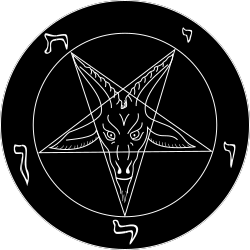
The sigil of Baphomet is a sigil of the material world, representing carnality and earthly principles. [1]
Contents
While the eponymous Baphomet had been depicted as a goat-headed figure since at least 1856, the goat's head inside an inverted pentagram was largely popularized by the modern Church of Satan, founded in 1966. [2] [3] [4] The Church adopted the sigil of Baphomet as their official insignia, describing the symbol as the "...preeminent visual distillation of the iconoclastic philosophy of Satanism." [5]

